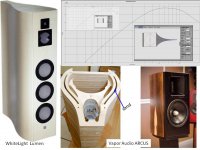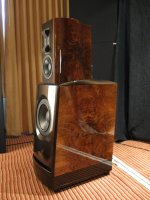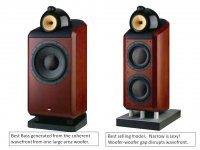Hi,
FWIW I can't imagine why anyone would ever need
two 10" professional drivers with 7mm excursion
for 80Hz+ in a domestic environment, and 105dB.
If your new to speaker design, don't run before
you can walk. I'd highly recommend building
any these four designs first off and a decent
used hifi amplifier :
Zaph|Audio - ZDT3.5
http://zaphaudio.com/Waveguidetmm.html
https://sites.google.com/site/undefinition/tarkus
https://sites.google.com/site/undefinition/diy-sunflowers
All of them can be moved on to grateful new
owners if they are not up to expectations.
rgds, sreten.
FWIW I can't imagine why anyone would ever need
two 10" professional drivers with 7mm excursion
for 80Hz+ in a domestic environment, and 105dB.
If your new to speaker design, don't run before
you can walk. I'd highly recommend building
any these four designs first off and a decent
used hifi amplifier :
Zaph|Audio - ZDT3.5
http://zaphaudio.com/Waveguidetmm.html
https://sites.google.com/site/undefinition/tarkus
https://sites.google.com/site/undefinition/diy-sunflowers
All of them can be moved on to grateful new
owners if they are not up to expectations.
rgds, sreten.
Last edited:
Hi,
FWIW I can't imagine why anyone would ever need
two 10" professional drivers with 7mm excursion
for 80Hz+ in a domestic environment, and 105dB.
If your new to speaker design, don't run before
you can walk. I'd highly recommend building
any these four designs first off and a decent
used hifi amplifier :
Zaph|Audio - ZDT3.5
Zaph|Audio
https://sites.google.com/site/undefinition/tarkus
https://sites.google.com/site/undefinition/diy-sunflowers
All of them can be moved on to grateful new
owners if they are not up to expectations.
rgds, sreten.
Partly because I have recommended it. Well, not just me. Mr. Lewinski is quite an intelligent engineer. He is a quick study and has several sources to use as
multiple references, and to cross check.
I, myself, use 2 each/per side a@ 12 inch professional drivers with an Xmax of 6.2mm to cover 60- to whatever it needs to be for any of my particular applications.
It's not hi-fi per say, it's done on a professional level, and a drum kit sounds like a drum kit.
I guess no tea for me today; straight from afternoon coffee, to beer !
Hi,
Well I'd say if your starting out on building speakers
going for the full monty first off is not a good idea.
Doesn't matter how intelligent you are, its how you
can use it, and lots needs to be applied to first builds.
YMMV, but IMO anyone should rein back their first build to
seemingly simple to the advantage of subsequent builds.
Going for broke on the first build leads to disappointment.
(You inevitably learn its not as great as you thought.)
At least reining back get you into the area of effectiveness,
and balancing cost effective compromises in the design.
All the designs I mentioned have possibilities in
the approach to the cabinet design, and are worth
building in terms of deciding the cabinet approach.
rgds, sreten.
Well I'd say if your starting out on building speakers
going for the full monty first off is not a good idea.
Doesn't matter how intelligent you are, its how you
can use it, and lots needs to be applied to first builds.
YMMV, but IMO anyone should rein back their first build to
seemingly simple to the advantage of subsequent builds.
Going for broke on the first build leads to disappointment.
(You inevitably learn its not as great as you thought.)
At least reining back get you into the area of effectiveness,
and balancing cost effective compromises in the design.
All the designs I mentioned have possibilities in
the approach to the cabinet design, and are worth
building in terms of deciding the cabinet approach.
rgds, sreten.
Last edited:
Hi,
Well I'd say if your starting out on building speakers
going for the full monty first off is not a good idea.
Doesn't matter how intelligent you are, its how you
can use it, and lots needs to be applied to first builds.
YMMV, but IMO anyone should rein back their first build to
seemingly simple to the advantage of subsequent builds.
Going for broke on the first build leads to disappointment.
(You inevitably learn its not as great as you thought.)
At least reining back get you into the area of effectiveness,
and balancing cost effective compromises in the design.
All the designs I mentioned have possibilities in
the approach to the cabinet design, and are worth
building in terms of deciding the cabinet approach.
rgds, sreten.
Sreten,
Thanks for the concern. You mean well. But I decided not to build any of those designs and take the risk. Don't assume I'll go full monty on the first build, though. What I'm doing is spending a lot of time understanding which drivers to use and having some design parameters/guidelines for the enclosures. Once I have the drivers I will test different enclosure prototypes and make adjustments until I settle on a design for a final build.
I have purchased Beyma TPL-150H for tweeters. I also have the the Hypex amps I'll use with the midbass, the subwoofers, and the crossover. As soon as I finalize the midbass selection I'll move on to prototype work. I was intrigued by TL as an improvement to add onto a sealed enclosure I had in mind. Maybe it's best to build a regular sealed enclosure and one with a TL inside and listen/measure for differences.
It's really useful to build quick and dirty prototypes of new speakers before settling on a final design where you pour blood and sweat into it. Try making some sealed Dagger type TL's with cheap foam core, triple ply cardboard, OSB, etc first. You will get a good sense of what is important. Then make it out of BB and veneer etc. make some small TL's with a 3in full range driver and you will see what I mean about low coloration. It acts like a much bigger box in the sense that it doesn't sound boxy. I think it is the ideal shape for mids. I made a 1.3L dagger for my 2-way mid/tweeter and it sounds open like an infinite baffle. That way I preserved more volume in main cabinet for the woofer.
A Dagger ?
What do you mean by "dagger" ?
Could it be some sort of solid device (shaped to kill vampires) inserted into a fixed volume in order to diffuse otherwise would-be standing waves ?
It's really useful to build quick and dirty prototypes of new speakers before settling on a final design where you pour blood and sweat into it. Try making some sealed Dagger type TL's with cheap foam core, triple ply cardboard, OSB, etc first. You will get a good sense of what is important. Then make it out of BB and veneer etc. make some small TL's with a 3in full range driver and you will see what I mean about low coloration. It acts like a much bigger box in the sense that it doesn't sound boxy. I think it is the ideal shape for mids. I made a 1.3L dagger for my 2-way mid/tweeter and it sounds open like an infinite baffle. That way I preserved more volume in main cabinet for the woofer.
What do you mean by "dagger" ?
Could it be some sort of solid device (shaped to kill vampires) inserted into a fixed volume in order to diffuse otherwise would-be standing waves ?
What do you mean by "dagger" ?
Could it be some sort of solid device (shaped to kill vampires) inserted into a fixed volume in order to diffuse otherwise would-be standing waves ?
"Dagger" is a name of a speaker cabinet that I coined. Basically, an unwound spiral Nautilus with advantage of no parallel walls anywhere. So Dagger is a long-ish 3-sided pyramid or obelisk-like tower. A normal obelisk is 4 sided. 3-sides means there are no parallel surfaces and the tapering tail when stuffed with fiberglass/wool/polyfill etc acts as acoustic black hole.
Here is example of it housing the mid/tweet inside a 25 liter box (leaving about 24 liters for main woofer).
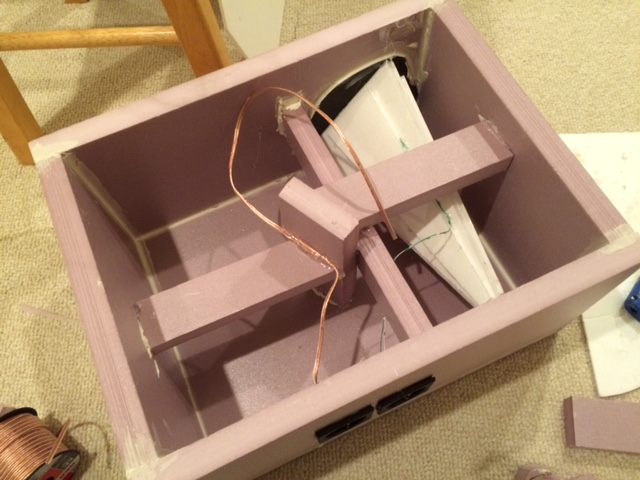
Here is how uncolored the sound is with a ScanSpeak 10F (no EQ applied):
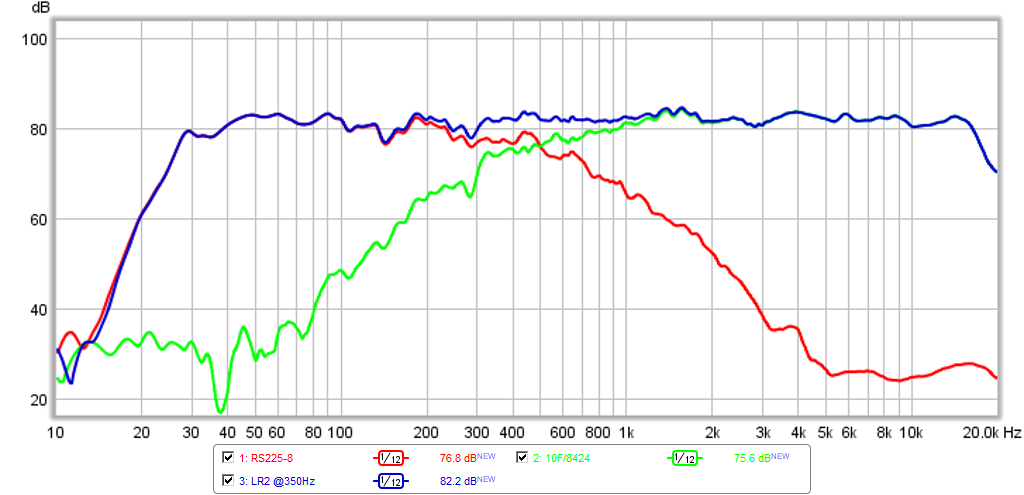
"Dagger" is a name of a speaker cabinet that I coined. Basically, an unwound spiral Nautilus with advantage of no parallel walls anywhere. So Dagger is a long-ish 3-sided pyramid or obelisk-like tower. A normal obelisk is 4 sided. 3-sides means there are no parallel surfaces and the tapering tail when stuffed with fiberglass/wool/polyfill etc acts as acoustic black hole.
Here is example of it housing the mid/tweet inside a 25 liter box (leaving about 24 liters for main woofer).

Here is how uncolored the sound is with a ScanSpeak 10F (no EQ applied):

Very interesting. Thanks for sharing.
So the Dagger has a triangular cross-section. What was the math you used for designing it? Even if super simple.
The Dagger is closed ended. Is the length equal to 1/2 wavelength of the lowest frequency in the range to be played by the midrange?
Do you take into consideration the resonant frequency of the midrange driver, like Martin King does with open ended TLs?
For an 8" midrange like I'm considering, the cross-section of the trinagle becomes a bit of a challenge, but I like the idea. I also like it for the tweeter.
The Vapor Audio ARCUS model uses the Beyma TPL-150H + Acoustic Elegance TD10M with a clever CNC-TransLam cabinet. There are several positive reviews on the Arcus which might help motivate your work + investment.
There are a few posts which quote B&W bass speaker experiments. B&W engineers felt that one 15" woofer produced a more coherent bass wavefront launch than two 10" woofers. BUT B&W marketing and sales has $$-proof that a narrow cabinet with two 10" woofers is sexier, easier to fit into a room, and sells...sells. sells better.
There are a few posts which quote B&W bass speaker experiments. B&W engineers felt that one 15" woofer produced a more coherent bass wavefront launch than two 10" woofers. BUT B&W marketing and sales has $$-proof that a narrow cabinet with two 10" woofers is sexier, easier to fit into a room, and sells...sells. sells better.
Attachments
The Vapor Audio ARCUS model uses the Beyma TPL-150H + Acoustic Elegance TD10M with a clever CNC-TransLam cabinet. There are several positive reviews on the Arcus which might help motivate your work + investment.
There are a few posts which quote B&W bass speaker experiments. B&W engineers felt that one 15" woofer produced a more coherent bass wavefront launch than two 10" woofers. BUT B&W marketing and sales has $$-proof that a narrow cabinet with two 10" woofers is sexier, easier to fit into a room, and sells...sells. sells better.
Keep in mind those B&Ws are designed as 3-ways, so the woofer needs to get as close to 20hz as possible. In that light it makes sense a 15" driver will perform nicely, right?
I keep going back and forth with one 12" vs two 10". On "paper" (or modelling spreadsheets) two 10" allow for nicer compensation of baffle step, floor bounce, etc. But maybe one 12" forced (by DSP as I will do) to compensate for baffle step et al would sound nicer?
FWIW, TAD Ref 1 also has two 10" drivers and they weren't shooting for sexier, I don't think. Aanyway, not saying two 10" is always better because anyone used it. Just trying to figure out what is best for my case.
For the record, I went on to read a fair amount about TLs and contacted Martin J. King.
In Martin's view, for my application a closed-end TL for the midbass would behave pretty much like a sealed cabinet, so likely not worth the effort. I might still go ahead and try a prototype just to enhance my understanding. But the odds are it won't be worth it.
I did take away an open-end TL seems like a good idea for the midrange. The line needs to be longer than a 1/4 wavelength of the driver's Fs for it to perform almost like an OB. Will try that out.
Martin has no experience with AMT tweeters and TLs. Will look further into this. An open-end TL for the tweeter seems like a good idea as well when it comes to dome tweeters, but I wonder how an AMT would behave in such an alignment. Anybody has experience?
In Martin's view, for my application a closed-end TL for the midbass would behave pretty much like a sealed cabinet, so likely not worth the effort. I might still go ahead and try a prototype just to enhance my understanding. But the odds are it won't be worth it.
I did take away an open-end TL seems like a good idea for the midrange. The line needs to be longer than a 1/4 wavelength of the driver's Fs for it to perform almost like an OB. Will try that out.
Martin has no experience with AMT tweeters and TLs. Will look further into this. An open-end TL for the tweeter seems like a good idea as well when it comes to dome tweeters, but I wonder how an AMT would behave in such an alignment. Anybody has experience?
Martin has no experience with AMT tweeters and TLs. Will look further into this. An open-end TL for the tweeter seems like a good idea as well when it comes to dome tweeters, but I wonder how an AMT would behave in such an alignment. Anybody has experience?
You may find some answers here:
http://www.diyaudio.com/forums/planars-exotics/232634-yet-another-diy-amt-10.html#post4337433
one basic question:
does it matter if there are too many bends added in the path of back wave? My idea is to divide a FS box of 1'x1'x4' into 4 compartments and place the woofer at one corner. such that, its rear wave travels thro all four compartments passing 3 bends. this way i can reduce the overall footprint and still get 1/2 wavelength path good enough to reach as much low in bass as possible.
does it matter if there are too many bends added in the path of back wave? My idea is to divide a FS box of 1'x1'x4' into 4 compartments and place the woofer at one corner. such that, its rear wave travels thro all four compartments passing 3 bends. this way i can reduce the overall footprint and still get 1/2 wavelength path good enough to reach as much low in bass as possible.
In a terminated TL it shouldn’t, except that you will have some effect if the lines are different lengths. Hegeman did a lot of work with the idea of many small different closed TLs in a closed box to help kill internal resonances.
dave
dave
Some hints. You’ll have todo some digging.
Started here:
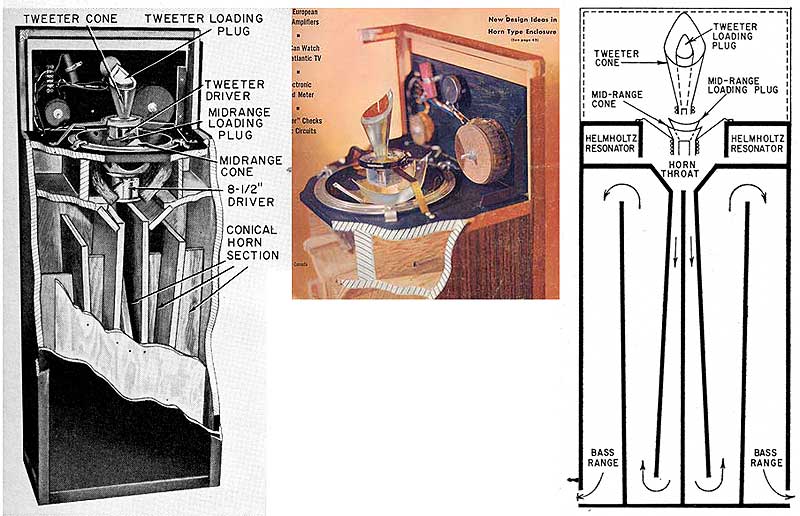
And ended with him passing his work onto Morrison: Speakers — Morrison Audio
I first ran into him with the Hegeman 1.
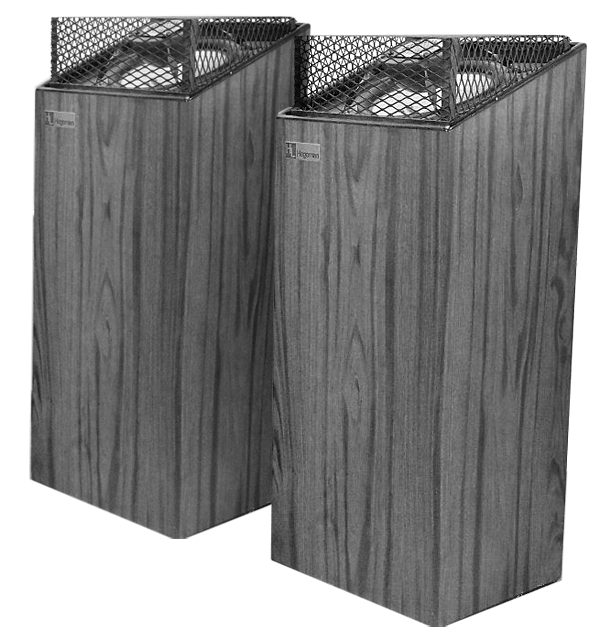
Hegeman Model 1 omnidirectional loudspeaker | Stereophile.com
The upfiring bit we have seen emulated fairly often. It is a bit inside that is what i found interesting. I wasn’t supposed to but i took one apart, it has a matrix of short little half-wave “TLs” that are intended to kill internal resonance, helping to kill the resonance peak and flatten the impedance.
Speaker builder had an article on the same sort of thing, but with only 4 lines.
dave
Started here:
And ended with him passing his work onto Morrison: Speakers — Morrison Audio
The rear wave of the woofer is loaded by a series of staggered length chambers which are sealed.
I first ran into him with the Hegeman 1.

Hegeman Model 1 omnidirectional loudspeaker | Stereophile.com
The upfiring bit we have seen emulated fairly often. It is a bit inside that is what i found interesting. I wasn’t supposed to but i took one apart, it has a matrix of short little half-wave “TLs” that are intended to kill internal resonance, helping to kill the resonance peak and flatten the impedance.
Speaker builder had an article on the same sort of thing, but with only 4 lines.
dave
…Martin has no experience with AMT tweeters and TLs. Will look further into this. An open-end TL for the tweeter seems like a good idea as well when it comes to dome tweeters, but I wonder how an AMT would behave in such an alignment. Anybody has experience?
I made a very short rear sealed TL for Heil ESS AMT. it worked very well - capturing the rear wave and putting it into an acoustic black hole. I called the short TL the “Dagger”. Basically a 4 or 5 sided tall pyramid with stuffing. It compares well to an infinite baffle in terms of no reflection from the back.
https://www.diyaudio.com/forums/multi-way/349546-ess-amt-1-projects-3.html#post6082784
It’s the pointy spike on the back of the horn:
XRK. I am already a proud owner of your 2way BS speaker using rs225 and FR in dagger. i am using 4" FR fu10rb in dagger. it plays mids and highs very cleanly. thanks
when designing boxes with only considering 1/2 wavelength path to absorb rear wave....any other driver parameters need to be considered? i am assuming the cross sectional area of path behind driver will be aprox equal to diameter of the driver cone.
- Home
- Loudspeakers
- Multi-Way
- Terminated transmission line for midbass?
